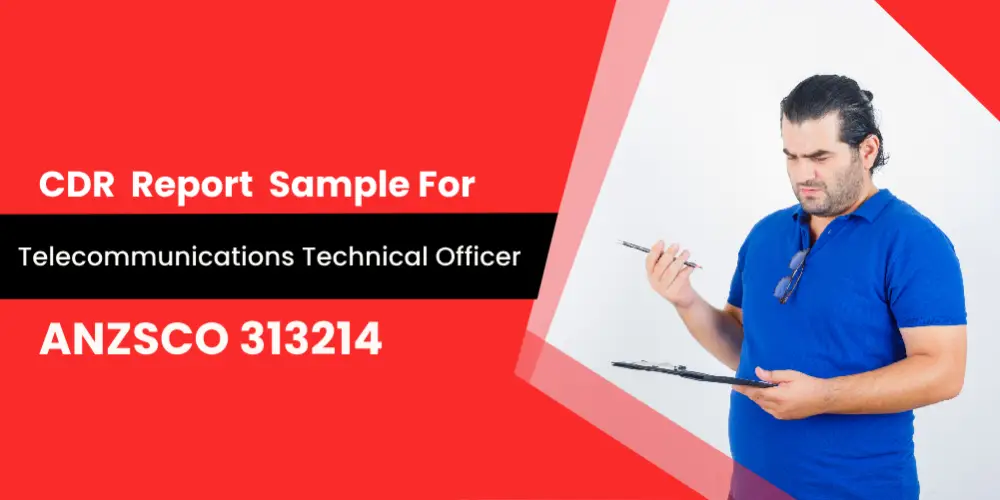Get Expert CDR, RPL, Stage 1, and Stage 2 Competency Samples for Reference
Contact to require a detailed analysis and assessment of your plan.
CDR Sample for Telecommunications Technical Officer

CDR sample for Telecommunication Engineers includes all the required reports such Curriculum Vitae (CV), Continuing Professional Development (CPD), three Career Episodes (CE), Summary Statement.The content of the CDR Report Samples is given below:
Curriculum Vitae (CV):
Resume on the basis of a professional template.
Continuing Professional Development (CPD):
CPD Sample clearly explains the author’s Engineering Knowledge- 1000 words.
Telecommunications Technical Officer Career Episode Report Sample – 1:
“Installation and Commissioning of NMS (Network Monitoring System)”- 2100 words.
Telecommunications Technical Officer Career Episode Report Sample – 2:
“Installation and Commissioning of BTS”- 2200 words.
Telecommunications Technical Officer Career Episode Report Sample – 3:
“Identification on the Issues using Network Drive Test and Optimization of the Network”- 2450 words.
Telecommunications Technical Officer Summary Statement Sample
Detail explanation of all the competency element- 1200 words
Telecommunication Technical Officer Career Episode 1
Project Name: Installation and Commissioning of NMS (Network Monitoring System)
Project Type:Work Based Career Episode
Engineering Activities of Telecommunication Technical Officer:
- To understand the requirement of the client and survey the related topic on the internet to get more familiar with the NMS installation.
- To select the various materials for cabling the power, materials for the ground cabling, materials and tools for the mounting of the GPS antenna and the cable routing.
- To resolve the problem that might arise during the installation of NMS, he planned to take extra equipment and tools, connectors and wires.
- To perform the site survey for all the location to determine the necessary requirements for the installation of the NMS, such as necessary power supply arrangement, availability of earthling system, etc.
- To make a call to engineers of each site to find out the exact location of the site in order to carry out all the necessary equipment and materials with him to that location.
- To begin the NMS installation for phase 1 through the installation of all the components and route the cables inside the shelter by placing the cable above the cable tray.
- To perform the installation of other equipment too such as PIU, battery bank, transmission track etc.
- To make a call to a network operation centre (NOC) and ask them to close the tasks of the site after ensuring the working of the equipment properly and tested all the sixteen alarms with the help of NOC.
- To prepare the ATP document, which ensure the proper connection of various wires and performed the test using a multimeter and eliminated the raised problem with the help of a teammate.
- To maintain a healthy relationship with his teammate and energize his professionalism while coordinating with the project coordinator, senior, operators etc.
- To make contact with many site engineers for sharing the idea and knowledge for the easiness in developing the project work.
- To coordinate with his teammate timely and made proper discussion in between them to accomplish the problem.
- To attend several meetings with the project coordinator and understand the basic need and method to enhance the project work.
Problems & Solutions
Problem 1 Career episode 1 and its solution
The very first problem was faced during the SMPS installation. He did not find any power in the SMPS. By utilizing his knowledge on the telecommunication and network, he checked the power from the wall socket. He found it was ok. Then, he checked the power switch of the cabinet and front panel of the motherboard. He found some problem in the cabinet. Despite being a telecom and network engineering, He learned a lot of information regarding electrical and electronics for this project, which helped him to accomplish this type of problem too. He fixed the problem of the power switch of the cabinet and hence resolved the problem to test the installation of SMPS.
Problem 2 Career episode 1 and its solution
Telecommunication Technical Officer Career Episode 2
Project Name: Installation and Commissioning of BTS
Project Type: Work Based Career Episode
Engineering Activities of Telecommunication Technical Officer:
- To hold a meeting with the vendors in the initial phase of the project to brief them about the planning and scheduling of the project.
- To plan about the sites where the installation of BTS was to be conducted on the basis of the present demand and future potential of the customers.
- To proceed towards performing the site survey and determining the feasibility of different requirement that might be necessary for the installation of BTS like availability of appropriate earthing system and arrangement of the required capacity of the power
- To investigate the flexibility of the location for its installation so that local people in that area does not get affected after the installation.
- To develop the site survey detail report which include all the details of the site, complying the requirements of the client.
- To install the surge arrestor for the purpose of protecting the equipment from the high voltage that might cause due to the external source as lightning and internal source as switching of the equipment.
- To mount the GPS antenna and install the cable tray when necessary with the labelling for all the cables and sectors.
- To alter the mechanical as well as the electrical tilt of the GSMs by adding the required parameters so that GSMs could have appropriate coverage.
- To work for the acceptance test, which was essential for determining the fulfilment of the requirements of the installation of the BTS in accordance with the requirement of the client.
- To also prepare the site folder and also include a very recording of the test conducted and finally submitted it.
- To ensure the safety of both the employee and machinery such as safety measures that needed to be adopted like preventive maintenance of the tolls, machines and equipment.
Problems & Solutions
Problem 1 Career Episode 2 and its solution
During the scheduling of the cables in the installation of BTS, initially, he made the use of three single core cables in the termination box of the system. Later he observed that on using the single core cables, it occupied a large space in the tray. Due to which, for making single connectivity, three single cores cable were required. The cables were also stacked. So to get rid of the problem faced, he consulted with the higher department head, and there they suggested him to make the use of the signal cable with three cores instead of three cables of a single core. As a result, it also occupied less space in the tray as well as there was no more problem of stacking of the cables which eventually helped in easy installation of BTS.
Problem 2 Career Episode 2 and its solution
Telecommunication technical officer Career Episode 3
Project Name: Identification on the Issues using Network Drive Test and Optimization of the Network
Project Type: Work Based Career Episode
Engineering Activities of Telecommunication technical officer:
- To held discussion sessions with the engineer from the client’s side, where he explained the various steps and stages the project would go through.
- He brief the engineers working in his team of the necessary protocols to adopt and the key performance index parameters.
- To then collect all the materials (both hardware and software) necessary for the Drive Test utilizing the resources of the company.
- To collect these components like a laptop with DT software installed (updated version), Dongle, GPS, Scanner and mobile phones to check the ranges and working conditions of the wireless media.
- To start the test for which he first divided folders for the collection and storage of the data from the tests.
- To make sure that the signals were analyze at different parts of the car, while stationary, while in motion, both inside and outside the car to get accurate readings and to find any sorts of faults.
- To make sure that layers like Pinpoint were activated along with cell event, AMR, with the addition of the RF layer, RF quality and coverage layer.
- To perform similar tests for setting up video calls with the use of dial command specific for video calls and keeping the call in a loop for the loop test and to find any sorts of faults.
- To use the software tools to create spider maps to see the dominant calls feeders and overshoot calls.
- To provide a suggestion regarding the increment of the height of the antenna for better line of sight followed by the adjustment of the antenna orientation adjustment and changing the ARFCNs.
Problems & Solutions
Problem 1 Career episode 3 and its solution
During the testing of the coverage signal, he found issues with the handover of the mobile signal. He found that the failure of the handover made the signal transfer to the older channel, and the calls were dropped. This resulted in a decrements of the signal quality. He thus suggested on the reorientation of the sectors for better network coverage to the network analyst. This was done for the longer and shorter calls that were dropped to decrease the failure rate.
Problem 2 Career episode 3 and its solution
Our Strengths
At WriteMyCDR, our core objective is to help clients secure successful skill assessment approvals by delivering well-structured, guideline-compliant reports tailored for migration purposes. We are committed to providing top-quality CDR services with a focus on accuracy, professionalism, and achieving 100% customer satisfaction.

Best Price Guarantee
We offer the most competitive rates without compromising on the quality of your report.

24/7 Service
If you have any questions or issues regarding your report, our experts are here to provide guidance and support.

Plagiarism Free Work
Get a fully original CDR report crafted by experienced professionals—plagiarism-free and tailored to meet official standards.

Best Price Guarantee
We offer the most competitive rates without compromising on the quality of your report.

24/7 Service
If you have any questions or issues regarding your report, our experts are here to provide guidance and support.

Plagiarism Free Work
Get a fully original CDR report crafted by experienced professionals—plagiarism-free and tailored to meet official standards.
